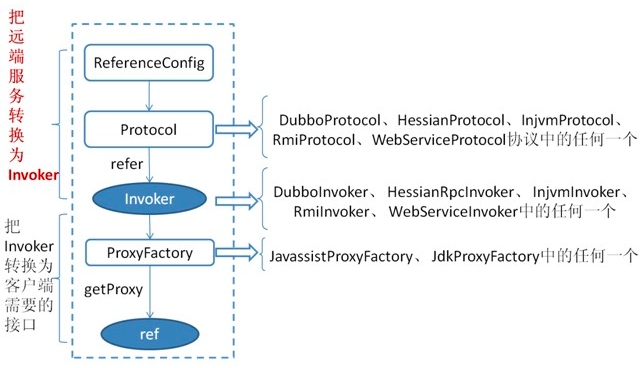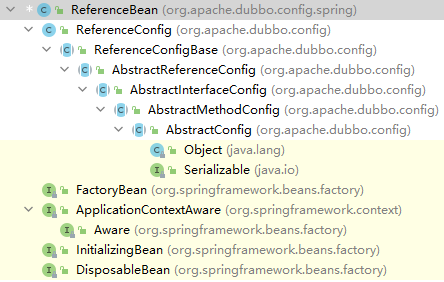Dubbo-服务消费者启动流程
参考:https://blog.csdn.net/prestigeding/article/details/80621535
Dubbo官网写的非常详细:https://dubbo.apache.org/zh/docs/v2.7/dev/source/refer-service/
设计图

ReferenceBean类结构图

ReferenceBean实现了InitializingBean接口,ReferenceBean#afterPropertiesSet方法
public void afterPropertiesSet() throws Exception {
// Initializes Dubbo's Config Beans before @Reference bean autowiring
prepareDubboConfigBeans();
// lazy init by default. 默认懒汉
if (init == null) {
init = false;
}
// eager init if necessary. 可通过配置 <dubbo:reference> 的 init 属性开启饿汉模式
if (shouldInit()) {
getObject();
}
}
ReferenceBean实现了FactoryBean接口,所以Spring的Application获得Bean时会调用ReferenceBean#getObject方法
/**
* 懒汉式,在 ReferenceBean 对应的服务被注入到其他类中时引用服务
*/
@Override
public Object getObject() {
return get();
}
public synchronized T get() {
if (destroyed) {
throw new IllegalStateException("The invoker of ReferenceConfig(" + url + ") has already destroyed!");
}
// 检测 ref 是否为空,为空则通过 init 方法创建
if (ref == null) {
// init 方法主要用于处理配置,以及调用 createProxy 生成代理类
init();
}
return ref;
}
ReferenceConfig#init源码分析
public synchronized void init() {
// 避免重复初始化
if (initialized) {
return;
}
if (bootstrap == null) {
bootstrap = DubboBootstrap.getInstance();
bootstrap.init();
}
// -------------------------------✨ 分割线1 ✨------------------------------
/**
* 1.检测 ConsumerConfig 实例是否存在,如不存在则创建一个新的实例,然后通过系统变量或 dubbo.properties 配置文件填充 ConsumerConfig 的字段
* 2.检测泛化配置,并根据配置设置 interfaceClass 的值
* 3.从系统属性或配置文件中加载与接口名相对应的配置,并将解析结果赋值给 url 字段。url 字段的作用一般是用于点对点调用
* 4.检测几个核心配置类是否为空,为空则尝试从其他配置类中获取
*/
checkAndUpdateSubConfigs();
// -------------------------------✨ 分割线2 ✨------------------------------
// 检测本地存根配置合法性
checkStubAndLocal(interfaceClass);
ConfigValidationUtils.checkMock(interfaceClass, this);
// -------------------------------✨ 分割线3 ✨------------------------------
// 添加 side、协议版本信息、时间戳和进程号等信息到 map 中
Map<String, String> map = new HashMap<String, String>();
map.put(SIDE_KEY, CONSUMER_SIDE);
ReferenceConfigBase.appendRuntimeParameters(map);
// 非泛化服务
if (!ProtocolUtils.isGeneric(generic)) {
// 获取版本
String revision = Version.getVersion(interfaceClass, version);
if (revision != null && revision.length() > 0) {
map.put(REVISION_KEY, revision);
}
// 获取接口方法列表,并添加到 map 中
String[] methods = Wrapper.getWrapper(interfaceClass).getMethodNames();
if (methods.length == 0) {
logger.warn("No method found in service interface " + interfaceClass.getName());
map.put(METHODS_KEY, ANY_VALUE);
} else {
map.put(METHODS_KEY, StringUtils.join(new HashSet<String>(Arrays.asList(methods)), COMMA_SEPARATOR));
}
}
map.put(INTERFACE_KEY, interfaceName);
// 将 ApplicationConfig、ConsumerConfig、ReferenceConfig 等对象的字段信息添加到 map 中
AbstractConfig.appendParameters(map, getMetrics());
AbstractConfig.appendParameters(map, getApplication());
AbstractConfig.appendParameters(map, getModule());
// remove 'default.' prefix for configs from ConsumerConfig
// appendParameters(map, consumer, Constants.DEFAULT_KEY);
AbstractConfig.appendParameters(map, consumer);
AbstractConfig.appendParameters(map, this);
MetadataReportConfig metadataReportConfig = getMetadataReportConfig();
if (metadataReportConfig != null && metadataReportConfig.isValid()) {
map.putIfAbsent(METADATA_KEY, REMOTE_METADATA_STORAGE_TYPE);
}
// -------------------------------✨ 分割线4 ✨------------------------------
Map<String, AsyncMethodInfo> attributes = null;
if (CollectionUtils.isNotEmpty(getMethods())) {
attributes = new HashMap<>();
// 遍历 MethodConfig 列表
for (MethodConfig methodConfig : getMethods()) {
AbstractConfig.appendParameters(map, methodConfig, methodConfig.getName());
String retryKey = methodConfig.getName() + ".retry";
// 检测 map 是否包含 methodName.retry
if (map.containsKey(retryKey)) {
String retryValue = map.remove(retryKey);
if ("false".equals(retryValue)) {
// 添加重试次数配置 methodName.retries
map.put(methodConfig.getName() + ".retries", "0");
}
}
// 事件通知配置:onreturn、onthrow、oninvoke等
AsyncMethodInfo asyncMethodInfo = AbstractConfig.convertMethodConfig2AsyncInfo(methodConfig);
if (asyncMethodInfo != null) {
// consumerModel.getMethodModel(methodConfig.getName()).addAttribute(ASYNC_KEY, asyncMethodInfo);
attributes.put(methodConfig.getName(), asyncMethodInfo);
}
}
}
// -------------------------------✨ 分割线5 ✨------------------------------
// 获取服务消费者 ip 地址
String hostToRegistry = ConfigUtils.getSystemProperty(DUBBO_IP_TO_REGISTRY);
if (StringUtils.isEmpty(hostToRegistry)) {
hostToRegistry = NetUtils.getLocalHost();
} else if (isInvalidLocalHost(hostToRegistry)) {
throw new IllegalArgumentException("Specified invalid registry ip from property:" + DUBBO_IP_TO_REGISTRY + ", value:" + hostToRegistry);
}
map.put(REGISTER_IP_KEY, hostToRegistry);
serviceMetadata.getAttachments().putAll(map);
// 创建代理类
ref = createProxy(map);
serviceMetadata.setTarget(ref);
serviceMetadata.addAttribute(PROXY_CLASS_REF, ref);
ConsumerModel consumerModel = repository.lookupReferredService(serviceMetadata.getServiceKey());
consumerModel.setProxyObject(ref);
consumerModel.init(attributes);
initialized = true;
// invoker 可用性检查
checkInvokerAvailable();
// dispatch a ReferenceConfigInitializedEvent since 2.7.4
dispatch(new ReferenceConfigInitializedEvent(this, invoker));
}
ReferenceConfig#createProxy源码分析
private T createProxy(Map<String, String> map) {
if (shouldJvmRefer(map)) { // 本地引用
// 生成本地引用 URL,协议为 injvm
URL url = new URL(LOCAL_PROTOCOL, LOCALHOST_VALUE, 0, interfaceClass.getName()).addParameters(map);
// 调用 refer 方法构建 InjvmInvoker 实例
invoker = REF_PROTOCOL.refer(interfaceClass, url);
if (logger.isInfoEnabled()) {
logger.info("Using injvm service " + interfaceClass.getName());
}
} else { // 远程引用
urls.clear();
// url 不为空,表明用户可能想进行点对点调用,绕过注册中心,消费者直连提供者
if (url != null && url.length() > 0) { // user specified URL, could be peer-to-peer address, or register center's address.
// 当需要配置多个 url 时,可用分号进行分割,这里会进行切分
String[] us = SEMICOLON_SPLIT_PATTERN.split(url);
if (us != null && us.length > 0) {
for (String u : us) {
URL url = URL.valueOf(u);
if (StringUtils.isEmpty(url.getPath())) {
// 设置接口全限定名为 url 路径
url = url.setPath(interfaceName);
}
// 检测 url 协议是否为 registry,若是,表明用户想使用指定的注册中心
if (UrlUtils.isRegistry(url)) {
// 将 map 转换为查询字符串,并作为 refer 参数的值添加到 url 中
urls.add(url.addParameterAndEncoded(REFER_KEY, StringUtils.toQueryString(map)));
} else {
// 合并 url,移除服务提供者的一些配置(这些配置来源于用户配置的 url 属性),
// 比如线程池相关配置。并保留服务提供者的部分配置,比如版本,group,时间戳等
// 最后将合并后的配置设置为 url 查询字符串中。
urls.add(ClusterUtils.mergeUrl(url, map));
}
}
}
} else { // assemble URL from register center's configuration
// if protocols not injvm checkRegistry
if (!LOCAL_PROTOCOL.equalsIgnoreCase(getProtocol())) {
checkRegistry();
// 加载注册中心 url
List<URL> us = ConfigValidationUtils.loadRegistries(this, false);
if (CollectionUtils.isNotEmpty(us)) {
for (URL u : us) {
URL monitorUrl = ConfigValidationUtils.loadMonitor(this, u);
if (monitorUrl != null) {
map.put(MONITOR_KEY, URL.encode(monitorUrl.toFullString()));
}
// 添加 refer 参数到 url 中,并将 url 添加到 urls 中
urls.add(u.addParameterAndEncoded(REFER_KEY, StringUtils.toQueryString(map)));
}
}
// 未配置注册中心,抛出异常
if (urls.isEmpty()) {
throw new IllegalStateException("No such any registry to reference " + interfaceName + " on the consumer " + NetUtils.getLocalHost() + " use dubbo version " + Version.getVersion() + ", please config <dubbo:registry address=\"...\" /> to your spring config.");
}
}
}
// 单个注册中心或服务提供者(服务直连,下同)
if (urls.size() == 1) {
// 调用 RegistryProtocol 的 refer 构建 Invoker 实例
invoker = REF_PROTOCOL.refer(interfaceClass, urls.get(0));
} else { // 多个注册中心或多个服务提供者,或者两者混合
List<Invoker<?>> invokers = new ArrayList<Invoker<?>>();
URL registryURL = null;
// 获取所有的 Invoker
for (URL url : urls) {
// 通过 refprotocol 调用 refer 构建 Invoker,refprotocol 会在运行时
// 根据 url 协议头加载指定的 Protocol 实例,并调用实例的 refer 方法
invokers.add(REF_PROTOCOL.refer(interfaceClass, url));
if (UrlUtils.isRegistry(url)) {
registryURL = url; // use last registry url
}
}
if (registryURL != null) { // registry url is available
// for multi-subscription scenario, use 'zone-aware' policy by default
// 如果注册中心链接不为空,则将使用 ZoneAwareCluster
String cluster = registryURL.getParameter(CLUSTER_KEY, ZoneAwareCluster.NAME);
// The invoker wrap sequence would be: ZoneAwareClusterInvoker(StaticDirectory) -> FailoverClusterInvoker(RegistryDirectory, routing happens here) -> Invoker
// 创建 StaticDirectory 实例,并由 Cluster 对多个 Invoker 进行合并
invoker = Cluster.getCluster(cluster, false).join(new StaticDirectory(registryURL, invokers));
} else { // not a registry url, must be direct invoke.
String cluster = CollectionUtils.isNotEmpty(invokers)
? (invokers.get(0).getUrl() != null ? invokers.get(0).getUrl().getParameter(CLUSTER_KEY, ZoneAwareCluster.NAME) : Cluster.DEFAULT)
: Cluster.DEFAULT;
invoker = Cluster.getCluster(cluster).join(new StaticDirectory(invokers));
}
}
}
if (logger.isInfoEnabled()) {
logger.info("Refer dubbo service " + interfaceClass.getName() + " from url " + invoker.getUrl());
}
/**
* @since 2.7.0
* ServiceData Store
*/
String metadata = map.get(METADATA_KEY);
WritableMetadataService metadataService = WritableMetadataService.getExtension(metadata == null ? DEFAULT_METADATA_STORAGE_TYPE : metadata);
if (metadataService != null) {
URL consumerURL = new URL(CONSUMER_PROTOCOL, map.remove(REGISTER_IP_KEY), 0, map.get(INTERFACE_KEY), map);
metadataService.publishServiceDefinition(consumerURL);
}
// create service proxy 生成代理类
return (T) PROXY_FACTORY.getProxy(invoker, ProtocolUtils.isGeneric(generic));
}




